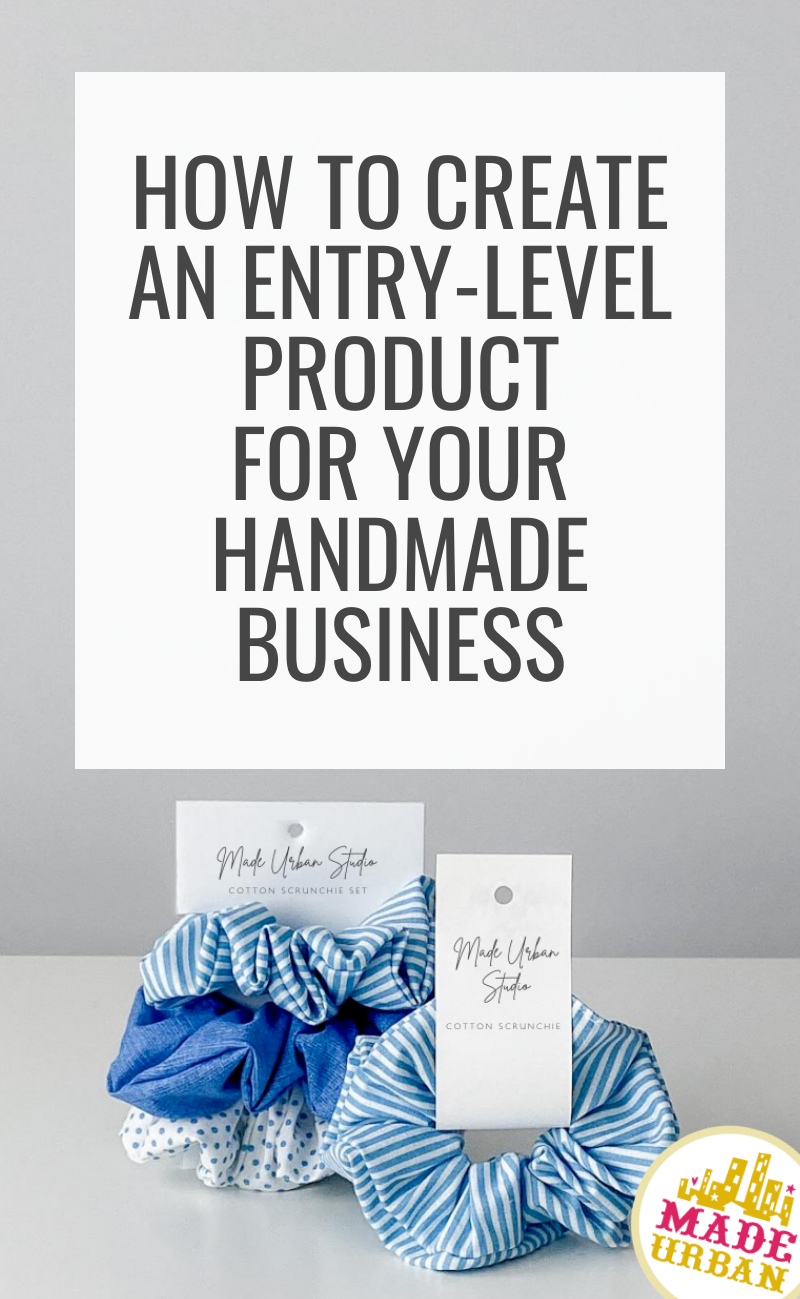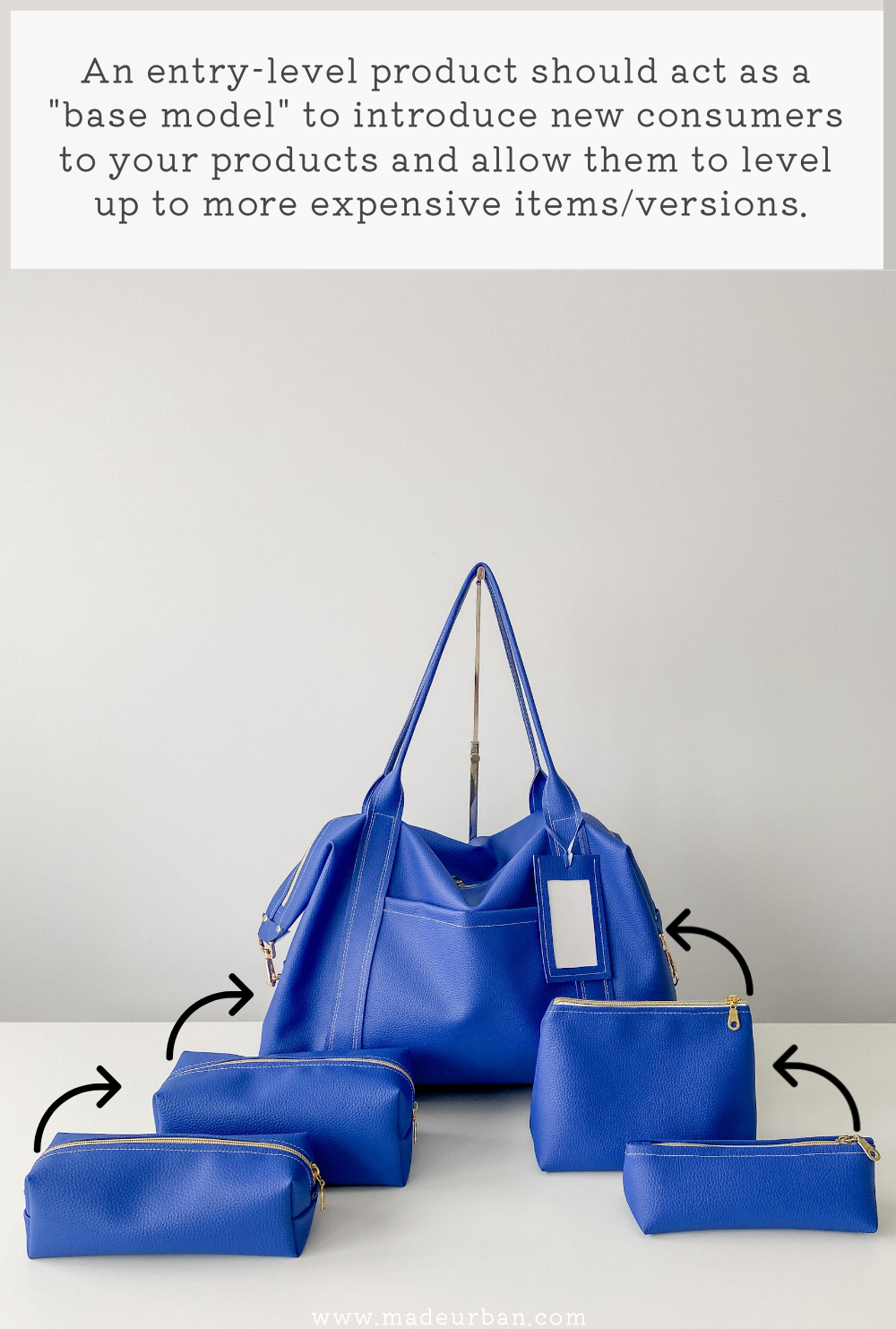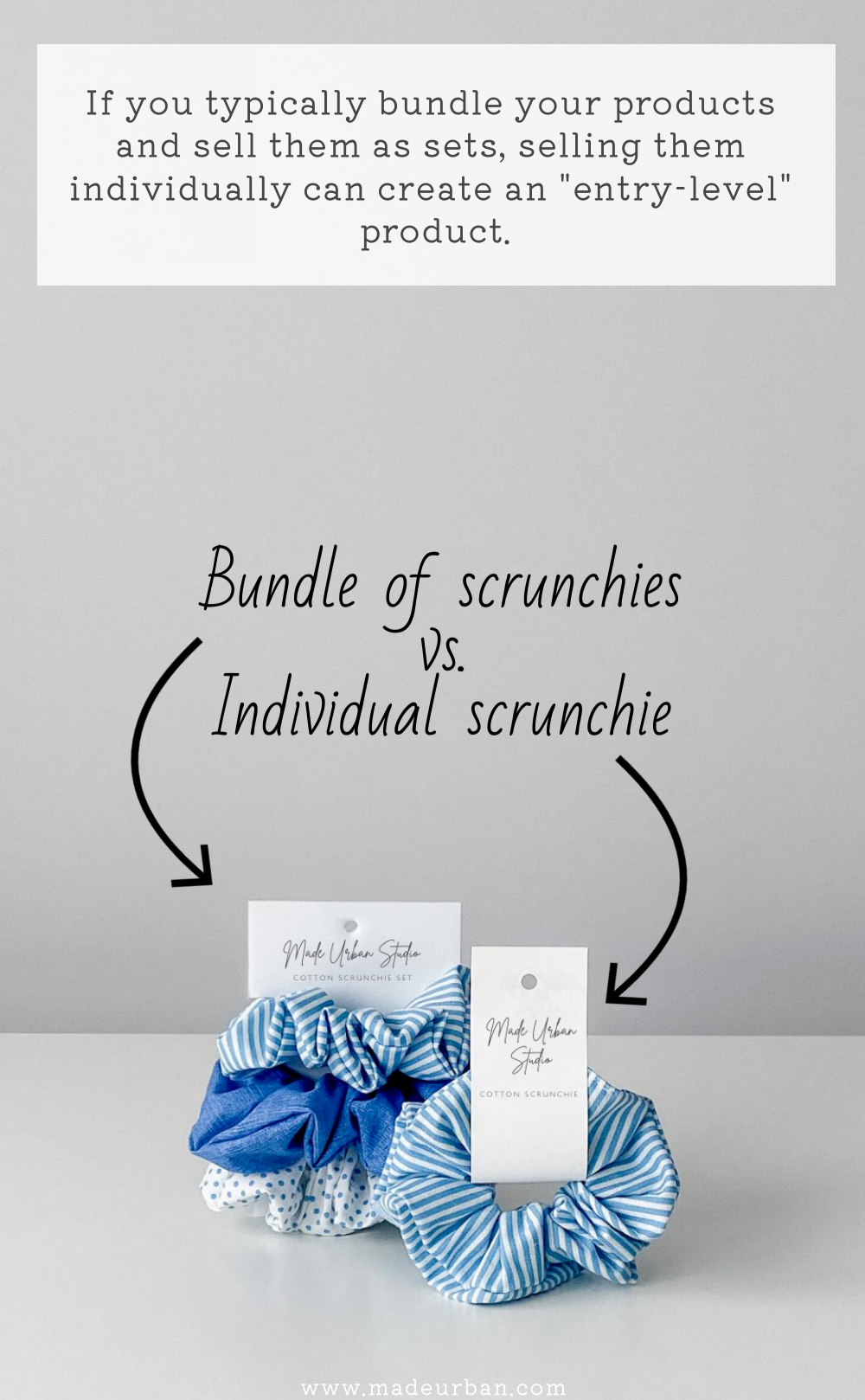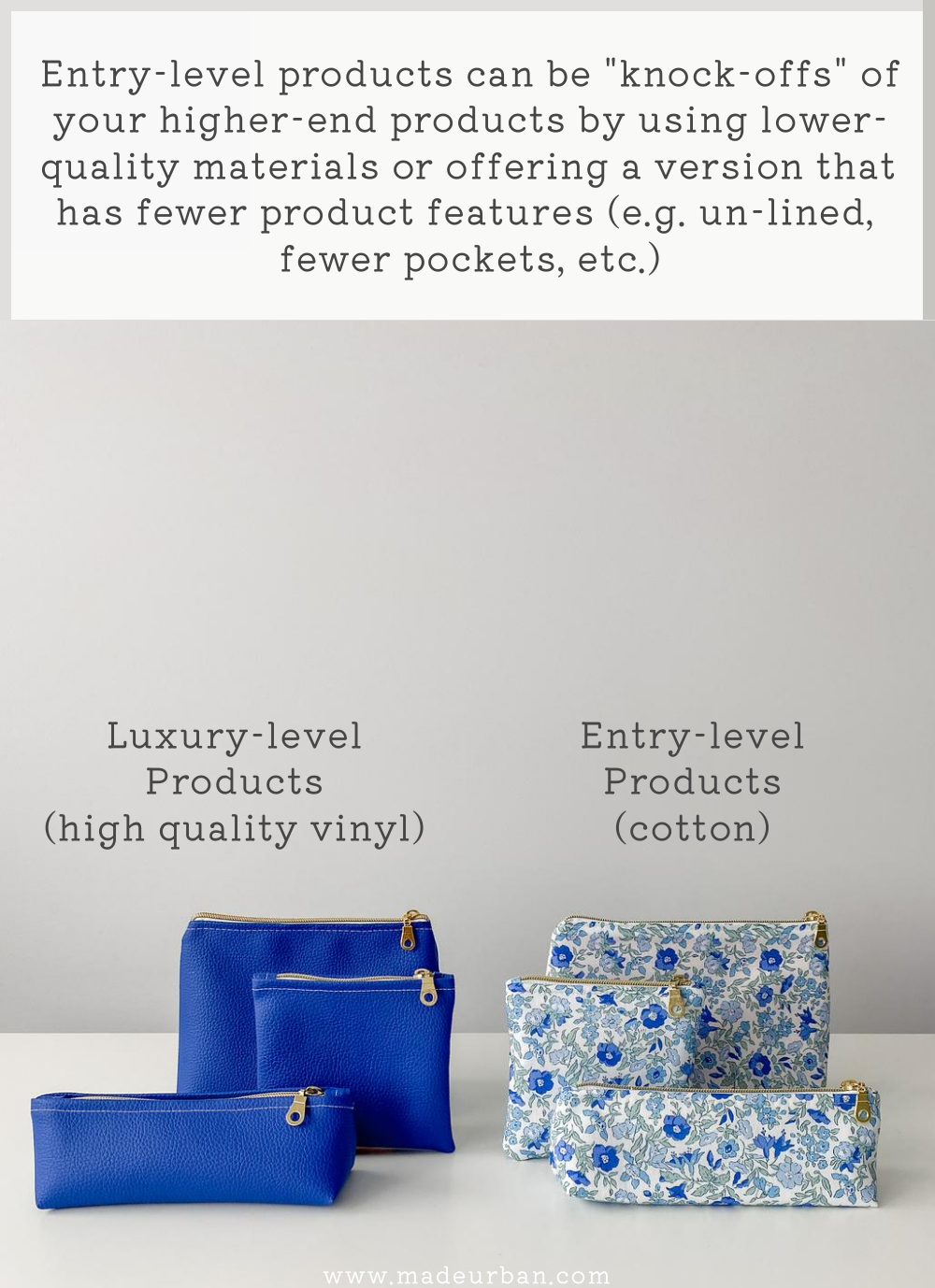How to Create an Entry-Level Product for your Handmade Business
To get new customers, you must constantly attract new people to your business and products.
When a shopper is “new” to your business it means they’re not familiar with your brand or products, which makes them less prepared to buy from you.
If you’re looking to buy a new necklace and head to a jewelry store you’ve shopped in before, you’re familiar with:
- the type of jewelry they sell
- their prices
- customer service
- etc.
You know what to expect and are prepared to buy.
On the other hand, if you stumble upon a new jewelry store, you may find something you love, but you may need to think about it before being ready to buy.
Prior to stopping in that store, you hadn’t been dreaming about a new necklace, planning where you’ll wear it or what you’ll wear it with, determining how much you can spend, etc.
You’re also not familiar with the jewelry store’s quality, customer service, history (e.g. did it open yesterday or has it been around for years?), etc.
You’re less confident about spending money with a business you’ve never heard of.
In this scenario, you’re not as prepared to buy.
However, that jewelry store can still make a sale and an “entry-level product” can help.

ENTRY-LEVEL PRODUCTS
An entry-level product lets a shopper experience the excitement that comes from buying something new but without the big commitment or price tag.
An entry-level product:
- Eases the shopper into becoming a customer
- Introduces them to the brand
- Acts as a reminder to come back and get that higher-priced item they were admiring
- Attract a new type of customer without having to lower your prices
An entry-level product is different than an add-on product in that it should showcase your talents and give customers a taste of what’s to come if they invest in one of your bestsellers.
For example, an add-on product for a jewelry maker may be a jewelry cleaner, jewelry storage bag, or jewelry box. But those items wouldn’t make good entry-level products because they don’t showcase the jewelry maker’s skills or encourage customers to come back and buy to add to their collection.

Below are a few keys to creating an effective entry-level product for your handmade business.
1) EASY TO BUY
At a craft show, people are more likely to have a 5, 10 or 20 dollar bill in their pocket than the correct change to spend $12, $27, $29.99, etc. If you can make a purchase easy, shoppers may be more likely to buy.
2) LOWER PRICE POINT
What’s considered a “lower price” will depend on your brand and your target market. For example:
>> Tiffany & Co’s customers know they’ll have to spend hundreds, if not thousands of dollars on a piece of jewelry. A $200 item would be considered a “lower price point” for them.
>> A business with the average price point being $100+ may set “lower price points” at $20 – $50.
>> And $5 may be a “lower price point” when sitting next to products in the $20 range.
Determine what would be a lower price point for your business, based on the average price of your products.
3) EXCITING
Entry-level products shouldn’t be regular items that are now on sale.
You don’t want to attract discount shoppers with your entry-level products (shoppers who are always on the hunt for a good deal).
You want shoppers who don’t mind paying full price for a quality item but just need a little more time to get to know your business.
Sometimes buying a sale item can be exciting to a consumer. But often, there’s a stigma of sale items being old stock a business wants to get rid of.
Buying an entry-level product should be just as exciting as buying an item from your regular line of products.
4) EASY TO ADOPT
Your entry-level product shouldn’t require a lot of thought. It should create an easy transition to becoming your customer. Meaning:
- The product shouldn’t need a complicated explanation (e.g. how it works, what it’s for, hidden benefits, etc.)
- The customer shouldn’t need to buy multiple items for it to work (e.g. a 5-step system)
- The product shouldn’t require a big lifestyle/mindset change
5) LESSER VALUE
Not quality, but value. Your entry-level product should make it clear that buying a product from your regular line is the better deal.
If shoppers can get the same value at a lower price point, they’ll be more likely to go for your entry-level product, even when they were planning to buy from your regular line of products. And we don’t want that.
>> For example, a business selling skincare products may offer a travel size of their best-selling jar of cream. Let’s say the travel jar of cream is 1/3 the size of the regular-sized jar, which is $30. It may seem logical to price the travel jar of cream at 1/3 the price of the regular-sized jar, making it $10. However, pricing it slightly higher (perhaps $15) shows customers who are open to the full-sized product that they’ll clearly get a better deal if they buy the full-sized jar.
Making your regular line of products the better value ensures people interested in your product are more likely to go for the regular line. Those skeptical or who need a little convincing can still try a product with less financial commitment; they just won’t get as much value for their money.
6) CREATES URGENCY
You want shoppers to want your product; you don’t want someone to buy because they felt rushed and made an impulse purchase they’ll regret later (that won’t encourage future sales). But you can create a little nudge to get someone who’s going to buy, to buy now instead of later.
You may create urgency by having limited quantities of your entry-level product available. That way, shoppers feel if they don’t buy now, they may not have the opportunity to purchase that product again (or anytime soon).
Or, you could create a bit of urgency by offering entry-level products for a limited time.
EXAMPLES OF ENTRY-LEVEL PRODUCTS
Each idea won’t work for every type of business, but you should be able to find one that works for the products you sell.
SAMPLES
Sample sizes of items can lower the price of your regular products and encourage more people to give them a try.
>> Someone selling skincare products may sell sample sizes to those interested but not quite ready to adopt a new skincare regime.
>> A candlemaker may offer tea lights in their most popular scents so customers can buy a small candle to burn at home and see how wonderful the scents smell.
>> A business selling food and drink products could offer sample sizes to take home and eat. The other option would be to offer samples to eat at their craft show booth to speed up the introduction process. Instead of making a small sale with hopes of making a bigger sale in the future, they may offer free samples at their craft show table in hopes of making a bigger sale that day.
SMALLER SIZES/QUANTITIES
If your products allow, you may simply offer them in smaller sizes or quantities to lower the price and create an entry-level product.
>> An artist selling original paintings may offer similar paintings in smaller sizes or applied to smaller items (e.g. magnets, calendars, note pads, etc.).
>> A jewelry maker may take the beautiful jewels used in their statement earrings and create smaller stud earrings with them. Or, a jeweller selling stacked ring and bracelet sets may sell the rings and bracelets separately so some people can buy one and add to it later to eventually create the stacked look.
>> A card maker may typically sell their cards in bundles of 5. Have a small selection of cards that can be purchased individually or mini cards could become and entry-level product.
>> A bag maker may offer a popular style of bag in a smaller size.

KNOCKOFF
Some consumers will purchase a knockoff Louis Vuitton purse until they can afford the real deal. A similar idea can be applied to your business, except you’re knocking off your own designs and creating a “lower quality” product that looks similar to your products using higher-quality materials.
If it’s not obvious, it must be communicated why the price is lower and the benefits of purchasing the more expensive version.
>> A jeweller offering stamped pieces in 24-karat gold may have an introductory line of gold-plated jewelry.
>> A handbag vendor selling leather bags may offer the same styles in cotton fabric.
>> Knitted cashmere scarves and hats may be offered in similar colors and patterns but using cotton yarn.

COMPLIMENTARY PRODUCT
An item that compliments your regular line of products not only works as an add-on to increase your sales per transaction, but it can also work as your entry-level product. Think about items that can work on their own or with other products you sell.
>> A bag vendor may create smaller cases/pouches that can be used with a larger bag to organize its content.
>> A clothing vendor selling cardigans and sweaters as the main product may offer t-shirts or tanks that can be worn under the hoodies, or on their own.
>> A jewelry vendor selling statement necklaces may offer earrings that can be worn on their own to add a pop of color, or with the necklace to compliment it.
>> An artist may sell smaller pieces of art that can be displayed on their own or with a larger piece of art to make a bigger statement and create a gallery wall.
>> A vendor selling knitted winter accessories might offer boot or wrist cuffs that add extra warmth when customers are wearing their items, or they can be purchased and worn on their own.
TRAVEL SIZES
Travel sizes or travel kits can also make a good entry-level product.
>> A toymaker may offer games or toys perfect for car or plane rides.
>> A bath and body vendor may bundle sample sizes of their 5-step skincare routine products and sell them in a travel case.
>> A candlemaker may offer candles in travel-size tins with lids.
ENCOURAGE REPEAT SALES
Now that the wheels are turning and you’re thinking about your entry-level product, here are a few more points to keep in mind as you start developing it.
These tips will encourage people who buy your entry-level product to come back and buy again.
1) LEAVES A GOOD IMPRESSION
Do not throw this product together and believe consumers will be happy with it simply because it’s a lower price point. Your entry-level product still needs to be valuable and leave customers feeling they received more value than they paid for.
This item introduces customers to your brand so you want them to be happy with their purchase so they come back and buy again.
If you’re offering “knockoff” versions of your products, which don’t use as high-quality materials/ingredients as your regular line of products, be sure to communicate that to customers and properly set their expectations.
2) LEAVES THEM WANTING MORE
Your entry-level product should simply be giving new customers a taste of what they’ll be getting with your regular line of products.
>> They may wear a piece of gold-plated jewelry and get lots of compliments, making them realize they want the piece to last forever and should purchase the 24-karat gold version.
>> Sample sizes of a skincare line should have enough product that the customer starts to see or feel the benefits but must buy them in full size to keep those benefits going.
>> Art prints offered in the same size as the original paintings may leave the customer feeling like they never need to upgrade. But a smaller print of the original painting they love allows them to hang it in their home, fall more in love with it, and be reminded each time they walk past it, how great the original would look hanging in their living room.
3) CREATES A GOOD EXPERIENCE
There can be a tendency to give the shopper looking at higher-priced products more care and attention than the shopper looking at lower-priced products.
Remember that, long term, you’re hoping the customer purchasing your entry-level product will become a loyal customer to your brand.
Provide the same level of customer service to all customers, no matter what they buy, or if they plan to buy from you again. They’re supporting your handmade business in the way they can afford to and you want them to have a good experience with you.
4) MAKES THE BENEFITS OF LEVELING UP CLEAR
It should be obvious to the customer that there is a benefit to purchasing an item from your regular line of products so they don’t just sit in entry-level-product-land forever.
In some cases, this may be clear. Obviously someone buying a sample size realizes they’ll get more product with the full size.
But in some cases, you may need to explain the difference.
>> Art lovers and collectors may understand the value of buying an original piece of art but to someone else, they may think “why not just buy the print? It’s way cheaper and looks almost the same.” The artist would want to communicate (either in-person at the craft show, or through a postcard that’s included with each print sold), the benefits of levelling up to an original piece of art.
>> A jewelry maker selling gold-plated entry-level products would want to clearly communicate how those pieces will wear compared to their 24-karat gold pieces, as well as any other benefits.
Knowing the benefit of levelling up will encourage more entry-level customers to come back and try the “real deal” product.
ALSO, KEEP IN MIND…
DISPLAY
Be sure to create a craft show display that clearly distinguishes the difference between your regular line and your entry-level line of products.
You may create a separate section for your “knockoff” products and use signage to point out the key features that make your entry-level products a lower price.
You want it to be crystal clear that they’ll be getting more value if they buy from your regular line of products, but that your entry-level products are a good alternative if they want to test the waters.
The jewelry vendor wouldn’t want a customer thinking they’re getting 24 karat gold at a steal of a deal price because the gold-plated entry-level piece was mixed in and they couldn’t tell the difference.
Join the free email course 5 DAYS TO A STANDOUT CRAFT SHOW DISPLAY if you need some ideas on how to display your products.
LEADS
Entry-level products may have lower profits than your regular line of products. For this reason, you want to be sure those entry-level products are generating new leads for your regular products.
If you continuously sell your entry-level products but you never see those customers come back and buy from you again, consider altering your entry-level product, or nixing it all together.
You may also be interested in:

Hey, I’m Erin 🙂 I write about small business and craft show techniques I’ve learned from being a small business owner for almost 2 decades, selling at dozens of craft shows, and earning a diploma in Visual Communication Design. I hope you find my advice helpful!

I sell Native American sterling silver jewelry. I Am proud to be creating authentic work. I like this article but could never do silver plated but I can and do offer smaller pieces that are less expensive but coordinate with higher end pieces. Good article.
Hello Erin, another great idea. My unique niches are Crepe Paper flowers, Cardstock Paper flowers and Cacti Desert Blooms. I have a way to do just what you said in this article. I create miniature flowers and Cactus by using both paper products. My cost is minimal for me to create these in a weekly basis. Heck, if I don’t sell them. I can just add them to a New flower arrangement. BTW, our state Fair is coming up in September 20th thru October 27th. They are closed Mon, Tues, and Wed. I will be on hand for all 24 days Demonstrating the Cricut Maker Cutting Machine, my skills/talents, and have the opportunity to Showcase/Sale my handcrafted creations. This is the 2nd year that I’ll be participating in Event that I was asked to come do as a free contractor because the Director and the Coordinator for the State Fair have been followers of mine for almost 1 and half. I’ll be doing Live FB Broadcast 5 times per day. I’m probably the luckiest arts and crafts small business owner. Have a GREAT day, Tim
I do this and it is very effective. I make suncatchers out of salvage/repurposed materials and always have houseplant suncatchers for $5. They are literally just crystals on a wire-wrapped stick. Cute, simple, and cheap.
Love your articles but I’m really struggling here… I’m an upholsterer.